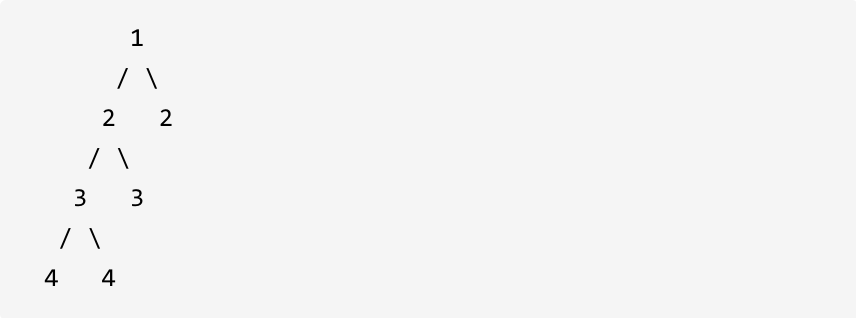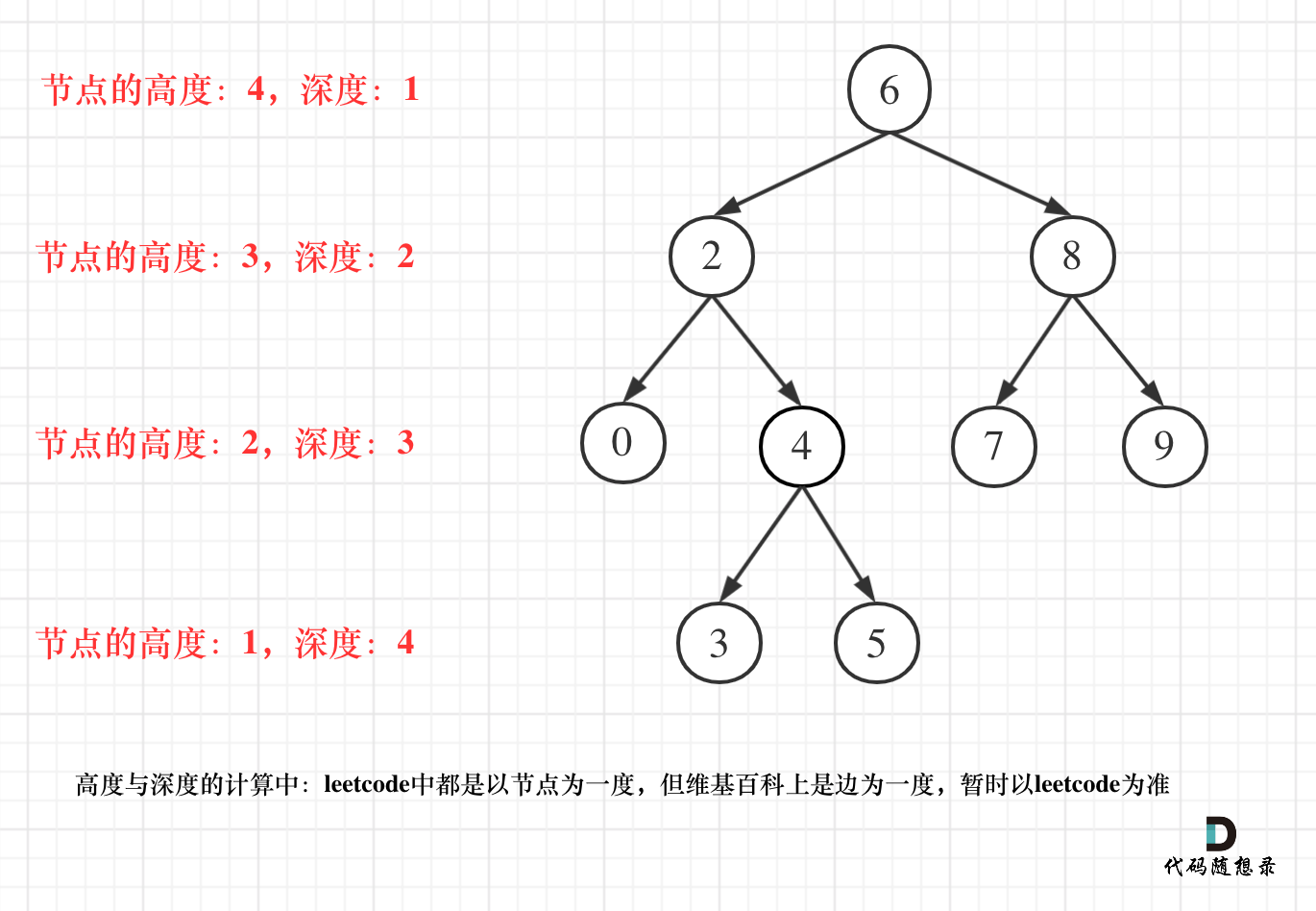



欢迎大家参与本项目,贡献其他语言版本的代码,拥抱开源,让更多学习算法的小伙伴们收益!
> 求高度还是求深度,你搞懂了不? ## 110.平衡二叉树 题目地址:https://leetcode-cn.com/problems/balanced-binary-tree/ 给定一个二叉树,判断它是否是高度平衡的二叉树。 本题中,一棵高度平衡二叉树定义为:一个二叉树每个节点 的左右两个子树的高度差的绝对值不超过1。 示例 1: 给定二叉树 [3,9,20,null,null,15,7]  返回 true 。 示例 2: 给定二叉树 [1,2,2,3,3,null,null,4,4]  返回 false 。 ## 题外话 咋眼一看这道题目和[二叉树:看看这些树的最大深度](https://mp.weixin.qq.com/s/guKwV-gSNbA1CcbvkMtHBg)很像,其实有很大区别。 这里强调一波概念: * 二叉树节点的深度:指从根节点到该节点的最长简单路径边的条数。 * 二叉树节点的高度:指从该节点到叶子节点的最长简单路径边的条数。 但leetcode中强调的深度和高度很明显是按照节点来计算的,如图:  关于根节点的深度究竟是1 还是 0,不同的地方有不一样的标准,leetcode的题目中都是以节点为一度,即根节点深度是1。但维基百科上定义用边为一度,即根节点的深度是0,我们暂时以leetcode为准(毕竟要在这上面刷题)。 因为求深度可以从上到下去查 所以需要前序遍历(中左右),而高度只能从下到上去查,所以只能后序遍历(左右中) 有的同学一定疑惑,为什么[二叉树:看看这些树的最大深度](https://mp.weixin.qq.com/s/guKwV-gSNbA1CcbvkMtHBg)中求的是二叉树的最大深度,也用的是后序遍历。 **那是因为代码的逻辑其实是求的根节点的高度,而根节点的高度就是这颗树的最大深度,所以才可以使用后序遍历。** 在[二叉树:看看这些树的最大深度](https://mp.weixin.qq.com/s/guKwV-gSNbA1CcbvkMtHBg)中,如果真正求取二叉树的最大深度,代码应该写成如下:(前序遍历) ```C++ class Solution { public: int result; void getDepth(TreeNode* node, int depth) { result = depth > result ? depth : result; // 中 if (node->left == NULL && node->right == NULL) return ; if (node->left) { // 左 depth++; // 深度+1 getDepth(node->left, depth); depth--; // 回溯,深度-1 } if (node->right) { // 右 depth++; // 深度+1 getDepth(node->right, depth); depth--; // 回溯,深度-1 } return ; } int maxDepth(TreeNode* root) { result = 0; if (root == 0) return result; getDepth(root, 1); return result; } }; ``` **可以看出使用了前序(中左右)的遍历顺序,这才是真正求深度的逻辑!** 注意以上代码是为了把细节体现出来,简化一下代码如下: ```C++ class Solution { public: int result; void getDepth(TreeNode* node, int depth) { result = depth > result ? depth : result; // 中 if (node->left == NULL && node->right == NULL) return ; if (node->left) { // 左 getDepth(node->left, depth + 1); } if (node->right) { // 右 getDepth(node->right, depth + 1); } return ; } int maxDepth(TreeNode* root) { result = 0; if (root == 0) return result; getDepth(root, 1); return result; } }; ``` ## 本题思路 ### 递归 此时大家应该明白了既然要求比较高度,必然是要后序遍历。 递归三步曲分析: 1. 明确递归函数的参数和返回值 参数的话为传入的节点指针,就没有其他参数需要传递了,返回值要返回传入节点为根节点树的深度。 那么如何标记左右子树是否差值大于1呢。 如果当前传入节点为根节点的二叉树已经不是二叉平衡树了,还返回高度的话就没有意义了。 所以如果已经不是二叉平衡树了,可以返回-1 来标记已经不符合平衡树的规则了。 代码如下: ``` // -1 表示已经不是平衡二叉树了,否则返回值是以该节点为根节点树的高度 int getDepth(TreeNode* node) ``` 2. 明确终止条件 递归的过程中依然是遇到空节点了为终止,返回0,表示当前节点为根节点的书高度为0 代码如下: ``` if (node == NULL) { return 0; } ``` 3. 明确单层递归的逻辑 如何判断当前传入节点为根节点的二叉树是否是平衡二叉树呢,当然是左子树高度和右子树高度相差。 分别求出左右子树的高度,然后如果差值小于等于1,则返回当前二叉树的高度,否则则返回-1,表示已经不是二叉树了。 代码如下: ``` int leftDepth = depth(node->left); // 左 if (leftDepth == -1) return -1; int rightDepth = depth(node->right); // 右 if (rightDepth == -1) return -1; int result; if (abs(leftDepth - rightDepth) > 1) { // 中 result = -1; } else { result = 1 + max(leftDepth, rightDepth); // 以当前节点为根节点的最大高度 } return result; ``` 代码精简之后如下: ``` int leftDepth = getDepth(node->left); if (leftDepth == -1) return -1; int rightDepth = getDepth(node->right); if (rightDepth == -1) return -1; return abs(leftDepth - rightDepth) > 1 ? -1 : 1 + max(leftDepth, rightDepth); ``` 此时递归的函数就已经写出来了,这个递归的函数传入节点指针,返回以该节点为根节点的二叉树的高度,如果不是二叉平衡树,则返回-1。 getDepth整体代码如下: ```C++ int getDepth(TreeNode* node) { if (node == NULL) { return 0; } int leftDepth = getDepth(node->left); if (leftDepth == -1) return -1; int rightDepth = getDepth(node->right); if (rightDepth == -1) return -1; return abs(leftDepth - rightDepth) > 1 ? -1 : 1 + max(leftDepth, rightDepth); } ``` 最后本题整体递归代码如下: ```C++ class Solution { public: // 返回以该节点为根节点的二叉树的高度,如果不是二叉搜索树了则返回-1 int getDepth(TreeNode* node) { if (node == NULL) { return 0; } int leftDepth = getDepth(node->left); if (leftDepth == -1) return -1; // 说明左子树已经不是二叉平衡树 int rightDepth = getDepth(node->right); if (rightDepth == -1) return -1; // 说明右子树已经不是二叉平衡树 return abs(leftDepth - rightDepth) > 1 ? -1 : 1 + max(leftDepth, rightDepth); } bool isBalanced(TreeNode* root) { return getDepth(root) == -1 ? false : true; } }; ``` ### 迭代 在[二叉树:看看这些树的最大深度](https://mp.weixin.qq.com/s/guKwV-gSNbA1CcbvkMtHBg)中我们可以使用层序遍历来求深度,但是就不能直接用层序遍历来求高度了,这就体现出求高度和求深度的不同。 本题的迭代方式可以先定义一个函数,专门用来求高度。 这个函数通过栈模拟的后序遍历找每一个节点的高度(其实是通过求传入节点为根节点的最大深度来求的高度) 代码如下: ```C++ // cur节点的最大深度,就是cur的高度 int getDepth(TreeNode* cur) { stack
* 时间复杂度:O(n)
*/
public boolean isBalanced(TreeNode root) {
if (root == null) {
return true;
}
Stack